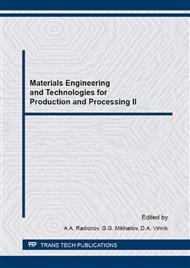[1]
TI 13657842-OA-01-2012, Technological instruction: The production of the fluxed sinter, JSC Ural Steel, Novotroitsk, (2012).
Google Scholar
[2]
L.A. Zaloznaya, A.N. Shapovalov, The production of high quality sinter at the sintering plant JSC Ural Steel, Science and production in the Urals. 2 (2006) 31-34.
Google Scholar
[3]
A.N. Shapovalov, E.V. Ovchinnikova, N.A. Maystrenko, The quality of sinter charge preparation for sintering in the conditions of JSC Ural steel, Theory and technology of metallurgical production. 1 (2014) 6-9.
Google Scholar
[4]
E.V. Ovchinnikova, N.A. Maystrenko, A.N. Shapovalov, Industrial testing of the surfactants use technology in sinter charge pelletizing, Russian Internet Journal of Industrial Engineering. 3 (2015) 3-12.
Google Scholar
[5]
V.D. Bondarenko, V.G. Zuz', Z.Z. Pastushenko, Sintering parameters study of the charge, treated by surfactants, Theory and practice of metallurgy. 1-2 (2010) 11-13.
Google Scholar
[6]
S.K. Sibagatullin, A.V. Ivanov, I.V. Reshetov, Use of organic binders in the iron ore agglomeration process, Vestnik of MGTU named after G. I. Nosov. 4 (2010) 30-32.
Google Scholar
[7]
T. Okada, J. Okazaki, M. Nakano, Improvement of granulation of raw materials with water soluble polymer, Zairyo to Prosesu - Current Advances in Materials and Processes. 4 (2003) 911.
Google Scholar
[8]
K. Holmberg, Surfactants and polymers in aqueous solutions: TRANS. from English, BINOM, Knowledge laboratory, Moscow, (2007).
Google Scholar
[9]
A.N. Shapovalov, E.V. Ovchinnikova, N.A. Maistrenko, Improving the Preparation of the Charge Used for Sintering at Ural Steel, Metallurgist. 3-4 (2015).
DOI: 10.1007/s11015-015-0085-6
Google Scholar
[10]
V.I. Korotich, Yu.A. Frolov, G.N. Bezdeschsky, Agglomeration of ore materials, Scientific edition, Ural State Technical University, Ekaterinburg, (2003).
Google Scholar
[11]
E.F. Vegman, Agglomeration of ores and concentrates, Metallurgy, Moscow, (1968).
Google Scholar
[12]
M.J. Pazyuk, V.N. Pogorelov, V.I. Grankowski, The charge preparation influence on the strength of sinter, Izvestiya vuzov: Ferrous metallurgy. 4 (1985) 21-24.
Google Scholar
[13]
A.N. Shapovalov, E.V. Ovchinnikova, The technological line modernization of sinter charge preparation for sintering in the conditions of JSC Ural Steel, Russian Internet Journal of Industrial Engineering. 2 (2013) 34-39.
DOI: 10.24892/rijie/20130205
Google Scholar
[14]
A.N. Emelyushin, S.P. Nefedyev, Investigation of the structure and impact-abrasive wear resistance of coatings of the FE-C-CR-MN-SI system, additionally alloyed with nitrogen, Welding International. 2 (2013) 150-153.
DOI: 10.1080/09507116.2012.695548
Google Scholar
[15]
S.P. Nefedyev, R.R. Dema, S.A. Nefedyeva, Microstructure of cast iron after plasma bleaching, Journal of Chemical Technology and Metallurgy. 2 (2015) 213-216.
Google Scholar
[16]
K.N. Vdovin, D.A. Gorlenko, A.N. Zavalishchin, Carbide transformations in tempering of complexly alloyed white cast iron, Metal Science and Heat Treatment. 5 (2015).
DOI: 10.1007/s11041-015-9848-8
Google Scholar
[17]
Y.F. Bakhmatov, K.G. Pashchenko, A.A. Kal'chenko, A.S. Belov, N.S. Tyuteryakov, Integrated process for drawing wire rod without a die plate and descaling the rod surface, Metallurgist. 3-4 (2014) 316-320.
DOI: 10.1007/s11015-014-9908-0
Google Scholar
[18]
S.A. Morozov, V.N. Degtyarev, V.N. Urtsev, A.V. Kaptsan, M.V. Shchipakina, Influence of preliminary deformation on the kinetics pearlite formation and its morphology on the eutectoidal composition, Steel in Translation. 9 (2004) 73-78.
Google Scholar
[19]
V.E. Proshunin, Cold-bound pelletizing of iron-containing wastes of a metallurgical enterprise on calcium-containing binders, Steel in Translation. 12 (1999) 6-10.
Google Scholar
[20]
A.A. Palant, Pelletizizng of sulfide molybdenyte concentrates, Russian metallurgy: Metally. 2 (2007) 109-111.
DOI: 10.1134/s0036029507020048
Google Scholar
[21]
Y.E. Proshunin, M.N. Gladshtejn, M.N. Pelikh, G.I. Usova, N.A. Zotkina, Choosing between bindersfor partial coal blend pelletizing, Coke and Chemistry. 4 (1994) 2-3.
Google Scholar
[22]
S.K. Kawatra, S.J. Pelletizing, Steel mill desulfuration slag, International Journal of Mineral Processing. 3-4 (2002) 165-175.
DOI: 10.1016/s0301-7516(01)00073-4
Google Scholar


